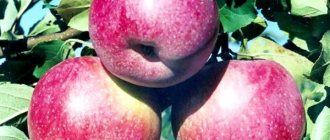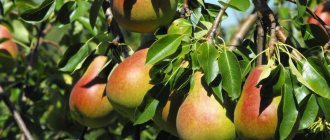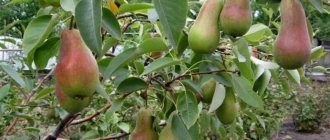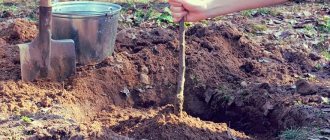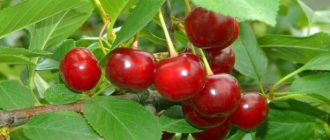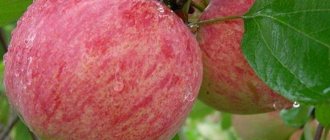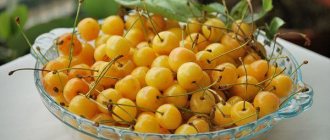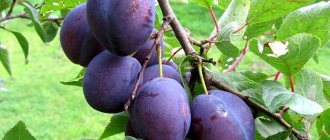Photo and description of the cherry variety Revna
The Revna cherry variety was bred by Russian breeders and adapted to the southern and central regions of the country. Hybrid species - Bryansk pink. There is a variety Revna 30–40 years old. Summer residents fell in love with it for its relative unpretentiousness. The crown of the plant is elongated, pyramidal in shape. The top is not thickened - the cherry fruits are not lost against the background of the leaves. The stem shoots are straight, do not get tangled as they grow, and gain thickness up to 10 cm. The foliage of the cherry tree is round, wide, and has pointed edges.
The crown is dark green. The berries of the Revna variety are burgundy with a black tint when ripe. The shape of the cherry fruit is elliptical. The pulp is dense, matching the color of the peel, and contains fructose, which gives the cherries their sweetness. Getting rid of the pit is not a problem, since it comes off without any remaining pulp.
Mature tree height
Cherry variety Revna does not grow more than 5 meters. This feature is a plus, because the crop is harvested without additional equipment.
Flowering and ripening period
The plant blooms from the second decade of May. The aroma attracts bees, which pollinate Revna cherries. The ovaries form after fertilization. From the appearance of inflorescences to ripe fruits – 2.5 months. In sunny and warm weather, the period is reduced to 2 months.
Productivity
In a good year, they harvest from 30 kg from one tree of the Revna variety. Since cherries are self-sterile, without the participation of pollinators the number of ovaries is less than 50%.
Transportability
The berry is not damaged during assembly, because it is separated from the stalk in one touch. Cherries without defects are stored longer. The Revna variety is transported in boxes of 5 kg. The durable skin protects the harvest along the way.
Frost resistance
The tree dies from early autumn frosts until the movement of sap has stopped. But in preparation for winter, it tolerates temperatures dropping to -27° Celsius. Late spring frosts are not terrible, because buds appear closer to summer.
History of selection
Cherry Revna is one of a number of varieties bred at the end of the last century by specialists from the All-Russian Research Institute of Lupine. The variety is named after the river of the same name, flowing in the Bryansk region, where the institute itself is located. The Bryanskaya Rozovaya variety was taken as the basis; selection was carried out using the free pollination method. The authors of the Revna cherry are breeders M.V. Kanshina and A.I. Astakhov.
In 1993, the cherry variety Revna successfully passed state tests and in 1994 was included in the State Register.
How to plant Revna cherries
Preparation is the key to proper planting of the Revna variety. It starts with choosing a seedling.
How to choose a seedling
A variety grown from seed becomes wild when it reaches the age of fruiting. Therefore, before purchasing, pay attention to the grafting of the seedling. Buy a two-year-old plant, because it has time to strengthen and will not die after planting. Inspect the root system. If there are few shoots and some of them are dry, then this is a sign of underdevelopment or disease.
Advice! If the roots have dried out during transportation, they should be immersed in water before planting.
Planting dates and scheme
The Revna cherry variety is planted after late spring frosts. They do this so that the young plant gets stronger before winter comes. Annual seedlings are kept in nurseries, because due to long shoots, sensitivity to low temperatures is higher. Over the spring and summer, the root system develops and strengthens. It is capable of delivering the required amount of moisture and nutrients from the ground to the branches.
Note! If the cherry tree has bloomed, then the planting time has passed.
Pit preparation
Before preparing the pit, select a site for the Revna variety. Cherry loves warmth, so air flows coming from the north are taken into account. It is preferable that this part be covered by a building. If the house or summer cottage is on a hill, then choose a southern slope. The plant does not like proximity to tall trees that cast shadows on the cherry tree. Sandstones and loams are favorite soils for the Revna variety. Clayey and swampy areas are not suitable due to stagnation of water after precipitation or melting snow. The root system rots from excess moisture.
Advice! If there is no choice and you have to plant in clay soil, then sand is added to it.
The hole is prepared in the fall so that the soil is saturated with nutrients over the winter. A hole is dug to a depth of 50–60 cm and a diameter of 70 cm. The selected soil is mixed with compost, which will require three buckets. A stake 1.5 meters long is inserted into the bottom. The root collar is placed 7 cm above the soil surface. This is necessary so that after shrinkage the scion site does not go underground. The hole is filled halfway with the prepared mixture and compacted. The planting site is moistened with ten liters of water.
After absorption, the hole is completely filled up and a mound is formed around the cherry trunk. It is necessary to retain the required amount of moisture for the plant. The soil is mulched with humus or peat and two buckets of water are poured under the tree. The seedling is tied to a driven stake using a figure eight, so as not to pinch the trunk.
How to choose a good seedling
It is best to purchase varietal cherry seedlings from specialized nurseries. When choosing them, you need to pay attention to the following points:
- Age. When purchasing, preference should be given to seedlings no older than 3 years.
- Bark – the color should be even, the surface without cracks or mechanical damage.
- The kidneys should be elastic and alive. Dry, brittle buds indicate the death of the seedling.
- The root system should ideally be well developed, consisting of at least 3-4 viable roots.
Vegetating seedlings with a closed root system are also popular. They cost more, but take root much better (the root system is not damaged during planting), and the trees begin to bear fruit earlier. You can plant them even in summer.
Advice! Even with a little uncertainty about the quality of seedlings, it is better to refuse to purchase them. Sick, weakened trees will not bear fruit well.
Cherry care Revna
The plant is given special attention until the age of five. It is inspected once every two weeks for the presence of pests and diseases.
Feeding and watering
Moisture is the key to harvest, but moderation is important. Under normal conditions, one watering per month is sufficient. If the summer is dry, then the frequency is increased fourfold. During rainy periods, artificial humidification is not required. If precipitation is heavy, drainage holes are formed through which excess water drains.
If the soil requirements are met, before planting the Revna variety, fertilizing the plant begins in the second year. They use rotted manure, which covers the needs of cherries. In the absence of humus, superphosphates, phosphates and urea are added. Substances are added when digging up an area near a tree in spring or autumn. The procedure is repeated after two years. To replenish the need for minerals, saltpeter is used. It is dosed so as not to burn the root system - 25 g per 1 m2. The substance is mixed with the soil before flowering and 2 weeks after. The indicated dose is divided into two times.
Weeding and loosening
Loosening the soil around the cherry improves air exchange, providing oxygen flow to the root system of the Revna variety. Weeding is carried out as the area becomes overgrown with weeds. Close attention is paid to this in the first year after planting. When the tree gets stronger, weeds are not a problem.
Crown formation
If you do not care for the crown of the Revna cherry, the number of shoots increases, taking away the strength of the plant. Excess branches block sunlight from the fruit, which slows down their ripening or sweetness development. They begin to prune cherries in the second year after planting. If you want to position the main branches at an angle of 90° to the trunk, shorten half of the shoot. Remove diseased, dry and damaged sprouts. A missed moment becomes a risk of damage to the tree. The top is also cut off so that the cherry does not waste energy on growth.
Pollinators of cherry Revna
The Revna cherry tree needs cross-pollination, so the following varieties are planted in the garden: Ovtuzhenka, Venyaminova, Iput and Kompaktnaya. Insects are attracted by spraying the trunk and foliage of the cherry tree with honey or sugar solution.
Landing Features
Since Revna is not self-fertile enough, other varieties of cherries must grow next to it: Ovstuzhenka, Iput, Tyutchevka, Raditsa. It is other varieties that are pollinators for a good harvest.
Selection of seedlings
1- and 2-year-old seedlings take root most well. When choosing planting material, you need to pay attention to the following points:
- The total height of the seedling should be 1–1.2 m.
- The crown should be sufficiently developed (not from 1-2 branches), with living buds. The branches should bend easily.
- The bark of the trunk and branches should be clean and smooth.
- The roots should be powerful, well branched, with the presence of small roots. The cut color should be light. Be sure to check elasticity and moisture.
- The grafting site should be free of cracks and stumps.
Try to choose the most developed seedling
Landing dates
Revna cherries can be planted in both spring and autumn, but take into account real weather conditions. It should be remembered that in cold climates, autumn planting (late September - October) is not recommended: the seedling may not have time to take root before frost. In spring, planting is carried out in April, after the soil has thawed. If a seedling is purchased at the wrong time, you can keep it in storage until spring.
The seedling is placed obliquely in the trench and covered with spruce branches for the winter.
Selecting a location
The correct choice of planting site largely determines the further development of the tree. Cherries require deep, fertile soils with good drainage. Places well-warmed by the sun and protected from cold winds are preferred.
In regions with a cold climate, it is recommended to plant cherries near buildings and fences - a slightly warmer microclimate is formed there. In addition, in such quiet “nooks” more snow accumulates in winter to cover the tree.
Sweet cherries, like cherries, do not tolerate excessive moisture. If the groundwater level is less than 1.5–2 m from the soil surface, you need to plant the tree on an artificial hill.
The cherry tree requires significant space, so the distance to other trees should be at least 4–5 m.
Soil preparation
The soil at the intended site should be prepared long before planting.
First of all, weeds are removed and the soil is dug to a depth of 20–25 cm. If the soil is heavily infested with perennial weeds, two-tier digging should be used.
Prepare a hole 2–3 weeks before planting (for spring planting it is recommended to do this in the fall). The pit should be about 1 m deep and 0.8 m in diameter, the walls should be made smooth, and the bottom should be loosened. At 1/3 of the depth, the hole should be filled with a nutrient mixture: 2 buckets of fertile soil, 2.5–3 buckets of humus, 0.6–0.8 kg of double superphosphate, 600–700 g of ash, 1–1.5 kg of ammonium sulfate. If the soil in the area is heavy, add 2-3 buckets of sand to the bottom of the hole before filling it with the nutrient mixture, and if the soil is sandy, add a layer of clay.
Landing
Revna cherries should be planted as soon as possible after purchasing the seedling. If it was stored in a trench, remove it from there only before planting.
The further development of the tree depends on proper planting
Planting is carried out in the following sequence:
- First install a stake in the hole that will support the seedling.
- Carry out a final thorough inspection of the seedling, trimming dried or broken roots and branches.
- Dip the roots into a clay mash.
- Plant the tree on a mound of soil mixture on the north side of the stake, straighten the roots.
- Sprinkle the soil in layers, shaking the seedling slightly so that all the spaces between the roots are evenly filled. Press each layer with your hands.
- When the hole is full, compact it with your foot.
- Tie the tree to a stake.
- Form a hole and pour 2-3 buckets of water into it.
Video: planting Revna cherries
https://youtube.com/watch?v=WrJcpbCMwDc
In mid-latitudes, it is better to plant cherries near a house or other buildings, since a warmer microclimate and additional protection from the wind are formed there.
Diseases and pests of Revna cherries
The Revna variety was bred to be resistant to frost and disease, so in a good year putrefactive processes do not develop on the tree. As a preventive measure, before and after cherry blossoms, the plant is sprayed with a universal remedy for stone fruit trees. An infrequent problem is cherry flies. If they are noticed on fruits and leaves, then the drug is selected individually depending on the area and climatic conditions. Birds feast on the cherry harvest. Protection against them is agrofibre thrown over the crown, a scarecrow or recorded sounds of birds of prey. The treatment of Revna cherries is described in the video.
Economic importance and application
During the flowering period of the cherry “jealous”, in April-May, it has no honey plant competitors. The same applies to the production of valuable propolis by bees. Beekeepers pay tribute to the variety for its good honey productivity: from each plant at this time they receive up to 36 kg/ha of useful products.
Rheubna cherries are ideal for fresh consumption and suitable for canning.
The dense skin of the berries, which are not prone to cracking, ensures preservation of their presentation during transportation.
Processing Revna cherries in spring
After the snow melts, the cherries are pruned and fed. Fertilizers are applied according to the recommendations listed above. Twice in May, a working solution of 1 liter of manure mixed with 10 liters of water is poured into the trunk circle of the Revna variety.
The branches of the Revna cherry are shortened before buds appear and the growing season begins. Select a period so that the air temperature is above 15 degrees day and night. The branches of a young tree of the Revna variety are shortened for the first five years to 50 cm every spring. In the sixth and subsequent years, it is shortened by 20 cm. The conductor is cut above the side branch and the sixth bud.
In the spring, they care for the trunk of the Revna cherry tree. This is necessary to prevent burns and illness. Add 500 g of copper sulfate, 3 kg of lime and 200 g of PVA glue to a bucket of water. The composition is mixed and applied to the trunk from the ground to large branches.
Specifics of growing a tree
Revna has some features that need to be taken into account when planting and caring. Cherries do not tolerate insufficient light, strong drafts, or close proximity to groundwater.
How to choose a place
This variety needs a sufficient amount of light, so the place for planting cherries should be well lit. The tree grows well on loam and sandy loam. The soil acidity level should be neutral.
Revna cherry, like other varieties, prefers to grow on a slight elevation. There should also be no strong drafts.
Soil preparation
If the acidity of the soil is increased, then liming is carried out. From 600 to 800 g of lime are added per 1 square meter, it is evenly scattered around the tree, then the ground is dug up. The first time this procedure is carried out is 6 months before planting the seedlings in the ground. It promotes better exchange of water and air in the soil. When liming, you cannot simultaneously fertilize the plant with nitrogen-containing products.
See also
Description and characteristics of the cherry variety Bull's Heart, cultivation and careRead
Selection of seedlings
The tree must have several strong shoots and a well-formed root system. There should be no visible damage on it.
If the seedling is not planted in the ground immediately or is to be transported, then the roots of the plant should be wrapped in a damp cloth.
Landing
It is preferable to plant cherries in the spring, in the second ten days of April. The air temperature must be at least 0 degrees. This should be done as follows:
- Dig a hole about 40 cm deep.
- Mix the soil with 2-3 buckets of compost. This mixture is poured in a heap onto the bottom of the resulting pit.
- Place a peg of a suitable size in the hole to further support the seedling. It is advisable to place it on the north side so that it does not block the light of the growing tree.
- Place the seedling in a hole, straighten the roots and cover them with soil.
- Form a circle around the trunk.
- Water the seedling with 10 liters of water.
Revna should be planted in such a way that the distance between it and other trees is at least 3 meters.
Pollinators
The variety is considered self-fertile, but the yield under self-pollination conditions is low. If there are no pollinators, the harvest will be only 5% of the possible one.
It is better to plant 2-3 other varieties of cherries next to this species, in which case the likelihood of a bountiful harvest in the future will be much higher.
The best pollinators for Revna cherries:
- Ovstuzhenka.
- Tyutchevka.
- Raditz
- Here we go.
Cherry blossoms bloom in the second ten days of May. During this period, the plant should be sprayed with a weak solution of honey to attract pollinating insects.
Preparing Revna cherries for winter
Cherries are prepared in the fall. The area around the plant is loosened and dug up. Carry out moisture-recharging irrigation, which will prevent freezing of the root system. This is done by adding 15 buckets of water under each Revna tree. If autumn is rainy, then this is not necessary, because excess moisture will lead to disease. Before the first frost, the trunk is covered with the whitewash mixture discussed above. A tree up to 5 years old is wrapped in geotextile and tied to a support so that the trunk is not damaged by the wind. To protect cherries from rodents, they surround the plant with spruce branches. As soon as snow falls, a meter-high cone-shaped slide is thrown at the bottom of the tree.
Harvest and storage
There are two main methods for collecting berries:
- shearing is a method that involves cutting off the berries along with part of the stalk, which helps to slightly increase the shelf life and transportability of cherries;
- milking - using this method, the cherries are collected in waterproof aprons, and then poured into containers lined with paper.
Did you know? The tallest recorded cherry tree reached a tree height of 30 m.
When starting to pick cherries, you should remember that slowing down can lead to shedding of berries and attracting insects and birds to the area. You can wait a maximum of a few days, provided there is rainy weather, since picking wet berries will lead to their rapid spoilage. There is also no point in picking cherries that are not yet ripe - these berries do not ripen. The optimal time for harvesting is the morning, but after the dew has dried. The shelf life of Revna, like other varieties of cherries, is low.
If picked together with the stems, the berries can be stored for a maximum of 2 weeks in cool cellar or refrigerator temperatures and about a week at room temperature.
Storing berries in plastic containers or sealed bags can slightly increase shelf life. For longer storage, freezing may be the only option. However, you should know that when defrosted and re-frozen, the berries will lose both appearance and taste.
Revna cherries are widely popular among owners of summer cottages, and rightly so - the high taste of the berries and absolute ease of care make this variety irreplaceable. And a high-quality and rich harvest, even with minimal effort, constantly attracts both professional gardeners and amateur beginners.
Advantages and disadvantages
Cherry Revna has the following positive qualities:
- bears fruit abundantly;
- The fruits have universal use;
- pleasant taste;
- high transportability;
- frost resistance of wood;
- crown size;
- stable immunity.
Disadvantages include the need to plant pollinator trees nearby, as well as late fruiting.
Pollinators of Revna
It is widely believed that cherries are a good pollinator for cherries, but in reality this is not the case - for successful cross-pollination it is necessary to plant plants of the same species nearby. Ideally, you need to plant 4-5 different varieties on the plot - this will significantly increase the chances of getting a good harvest. Since Revna is not able to bear fruit normally without third-party pollinators, the presence of other cherries next to her is simply necessary.
The best pollinators will be:
- And the way,
- Compact Venyaminova,
- Ovstuzhenka,
- Raditsa,
- Tyutchevka.



